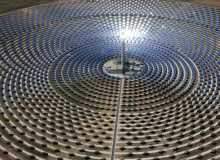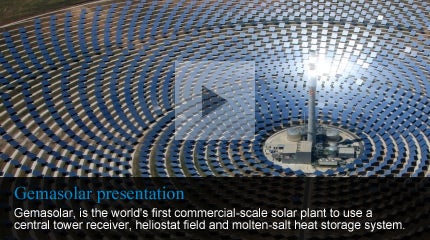
The biggest limitation that modern photovoltaic installations and other renewable energy sources face is their dependence on the environment. In the case of solar, non-stop power production is hampered by clouds, wind and darkness, when our demand is in fact peaking: we need power to light the streets, highways, shops and offices and also tend to maximise the use of appliances when returning home from work.

Discover B2B Marketing That Performs
Combine business intelligence and editorial excellence to reach engaged professionals across 36 leading media platforms.
This makes solar reliant on fossil fuels or peaking generators to step in and take on the job of powering our homes. Other power plants need to be scheduled to start for night time operations or during bad weather patches, which eventually leads to the question of how clean solar really is.
In May 2011, a new type of solar plant went online in the sunny region of Andalucía in Spain, claiming to tackle the issue by managing energy from the sun 24 hours a day and generating electricity at night.
Looking like a giant art installation with 2,650 panels spread across 185 hectares in the midst of nowhere, the 19.9MW plant promises to produce 110GW a year, enough to power 27,500 homes in the region.
However more importantly, it is guaranteeing electrical production for a minimum of 270 days annually, up to three times more than other renewable energy sources, all due to the fact that it can save heat from the sun for up to 15 hours.

US Tariffs are shifting - will you react or anticipate?
Don’t let policy changes catch you off guard. Stay proactive with real-time data and expert analysis.
By GlobalDataHailed as the world’s first nocturnal solar plant, some believe the technology could be a breakthrough for solar, leading the way to a future where the share of clean and renewable energy plays a major role in the overall energy mix.
Living by night
“We are not willing to have a non-reliable electricity supply which simply decreases the voltage during the night,” said Torresol Energy technical director Santiago Arias Alonso, explaining the need for a solar plant that produces power at night. The Spanish developer and operator of the plant, a joint venture between Spanish engineering and technology group Sener and Abu Dhabi’s renewable energy company Masdar, started the project in 2000 ‘from scratch’.
Eleven years later, the first concentrated solar power (CSP) plant went online near Seville in Spain and has since developed into a local attraction: the mirrored panels arranged in a circular pattern surrounding the 140m tower produce a spectacular picture. The design however is not arranged by chance but meticulously planned so that the plant’s mirrors, called heliostats, reflect 95% of the sun’s rays onto a small receiver on top of the tower.
“The control of the heliostats, each one adopting a different bi-directional angle to precisely concentrate the sunrays on the receiver, was not an easy task and took seven months to coordinate,” explained Arias Alonso.
On the tower, the heat of up to 900°C is used to warm molten salt tanks, which create steam to power the station’s turbines. In the tower, these salts are used directly as the heat absorption fluid: they get pumped from the cold tank to the receiver at the top of the tower, where they are heated to a temperature of 565°C, after which they descend to the heat exchanger to generate steam.
But unlike other solar stations, the surplus heat can be stored in a hot tank on the ground, allowing it to be used at times with low solar radiation, when the plant does not get enough heat to generate steam directly. The stored salt, which only loses 1% of the heat being stored each day, can then supply this heat and continue generating steam.
No limitations
According to Arias Alonso, the first outcomes of commercial production at the plant are promising. “Statistically speaking, many components of new installations tend to fail during the first year of operation,” he said.
“We’ve already passed the initial critical time without dying in the effort. We are in fact very optimistic about the technology, the achieved results and the possibility of creating new plants.”
In addition to the Gemasolar plant, Torresol already operates two other CSP plants in Spain, Valle 1 and Valle 2, located only about 200km from Gemasolar in Andalucía. There, the company uses more conventional parabolic technology but also reaches 7.5hr of thermal storage. Should Gemasolar’s technology prove successful, the company plans to promote the plants worldwide.
For Santiago Arias Alonso, the benefits compared to conventional photovoltaic installations are obvious: “We are not limited by the maximum oil temperature and we’re operating 200° above a normal operating temperature. Higher temperatures mean more efficiency as well as that each kg of salt is able to store a higher amount of energy, which makes storage cheap,” he said.
“It is so cheap that we designed the plant to operate 24/7 or 6,400hr a year. Most of the other solar plants in Spain operate 2,000hr a year.”
Some have however criticised the high cost of installation, with the cost of this first-of-a-kind plant to be £260m ($419m). This equates to $33 per average watt delivered, which is still several times higher than the cost of wind, geothermal or nuclear. But in comparison to other solar options it is only slightly higher.
Nocturnal solar panels
Elsewhere, another technology is poised to redefine the concept of solar generation and conversion, which in the end could also influence Torresol’s power plants. At the US Department of Energy’s Idaho National Laboratory in Idaho Falls, a new type of light-sensitive nanoantennas which harvest power from residual heat could double the output of conventional panels.
The most important element of the nano-scale antennas is their ability to collect infrared radiation (IR). Almost 50% of the potential energy harvested from the sun can be found in IR, discharged by the Earth’s surface after sunset. Idaho National Laboratory physicist Steven Novack, one of the pioneers in the area, estimates the antennas could harvest as much as 82% of the residual heat once fully developed.
First tests show they are currently able to harvest about 46%, a sharp increase from the current version of silicon solar cells, which have efficiency rates of about 25%.
“The antennas are very good at collecting energy and with the right combinations of diodes we should be able to collect high efficiencies,” he said. “Moreover, manufacturing costs are going to be much lower than conventional solar panels because we’re not using exotic materials and going to apply a roll-to-roll manufacturing process. ”
High-frequency diodes
According to Novack, the flexibility of the antennas is going to be fairly high, they will be able to absorb energy from a wide range of angles, and if implemented on a larger scale, the technology could help redefine how we harness power from the sun. One of the biggest challenges now is being able to convert and store the produced currents.
Available silicon diodes, which are crucial to energy conversion, do not operate at the high frequencies required by the antennas.
University of Colorado professor of engineering Garret Moddel has made it his duty to tackle the issue, and in cooperation with Steven Novack and his team has created what is known as tunnelling diodes, which are capable of handling high optical frequencies.
“That was one of the biggest challenges we defined and now we are in the course of getting funding to couple the antennas and diodes together in a manufacturing prototype in order to get the energy out,” explained Novack.
Looking ahead, he reckons that Torresol’s molten salt technology for storing heat could also work for applications with nanoantennas, as the temperature differential is set to be as high as at Gemasol. “But we want to give the research a little more advance before we start this process,” he said.
A bright future?
It seems that all efforts are being made to finally unleash solar power from the chains of the sun. After six months of running Gemasolar, 27.5 million KW of energy were produced, even if the ‘technological learning phase’ had not yet been concluded.
Santiago Arias Alonso is optimistic: “CSP produces clean energy but is as manageable as gas, coal, biomass or other sources of conventional thermal energy. If solar power has a future, CSP has a role in it.”
Steven Novack on the other hand envisions the future of solar power being driven by different types of nano-materials, instead of traditional silicon solar panels, as the industry will be responding to the newly gained efficiency and the lower costs.
He doubts however that it will revolutionise a whole industry and bring solar on track of becoming a major player in the overall energy mix.
The new technologies and their first successes are a step in the right direction, making an attempt to resolve the biggest issue in solar power there is – its dependence on the sun – and making it available 24 hours a day.
Gemasolar Concentrated Solar Power, Spain
Gemasolar is a 19.9MW, small scale concentrated solar power plant (CSP) located in the city of Fuentes de Andalucía in the Seville province of Spain. It is the world’s first commercial-scale plant to use solar technology comprising of the central tower receiver, a heliostat field and a molten-salt heat storage system.





